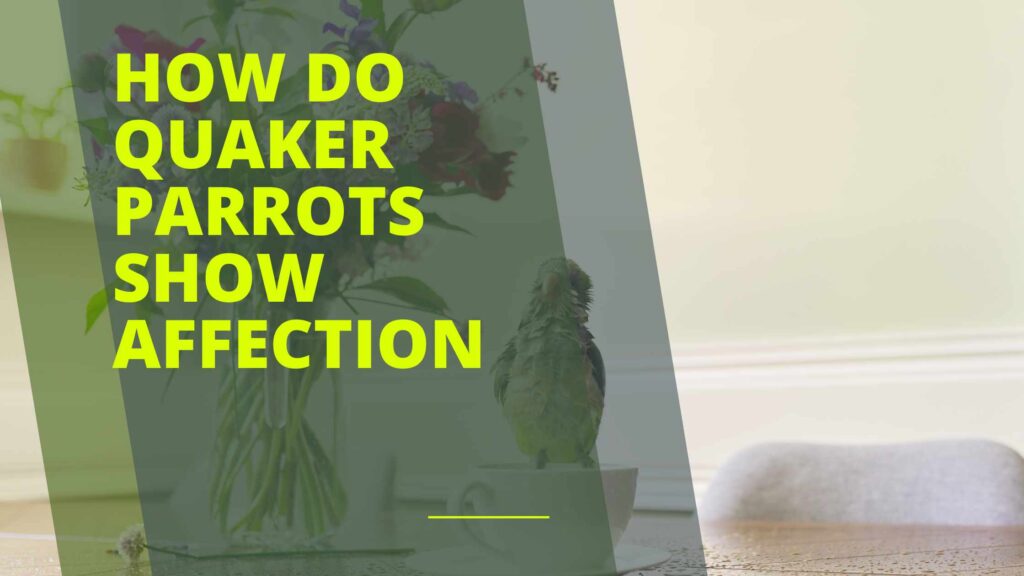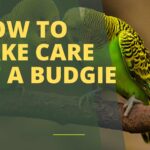Quaker parrots show affection through cuddling and mimicking speech. They often express their fondness by gentle beak nibbling.
Exploring the social behaviors of Quaker parrots reveals that these vibrant birds have a unique way of displaying love to their owners and feathered companions. Known for their sociable nature, Quaker or Monk parakeets engage in close physical contact as a sign of affection, such as snuggling up to their human friends or resting against them.
How Do Quaker Parrots Show Affection? The highly intelligent Quaker parrot also uses vocalization to bond, imitating words and sounds to communicate and create a deeper connection with their human family. Their playful antics, like beak nibbling, are gentle affirmations of their affectionate and loyal temperament, making them adored pets among bird enthusiasts. Understanding and recognizing these affectionate gestures build a trusting and enduring relationship with these charming and affectionate companions.
Quaker Parrots: A Bundle Of Love
The Quaker parrot, also known as a Monk parakeet, is more than just a pet. These little birds overflow with affection, often forming deep bonds with their owners. Quaker parrots express love in remarkable ways, making them unique companions in the avian world.
Origins Of Quaker Parrots
Quaker parrots hail from South America. They thrive in temperate regions. In the wild, they build strong communities, known for their intricate nests. These qualities translate into their ability to love and bond in a domestic setting.
The Bonding Quirk Of Quakers
Quakers show affection through their bonding quirk. Eye contact, gentle beak chews, and feather ruffling are signs a Quaker parrot cherishes its human. They may learn to imitate human speech, calling out to their favorite person.
Quaker parrots need social interaction. Without it, they might feel lonely. Spend time with these lovely birds, and watch the bond grow. They respond to affection with sweet gestures, underlining their reputation as a bundle of love.

Credit: parrotjunkie.com
Understanding Quaker Parrot Behavior
Quaker parrots, also known as Monk parakeets, are expressive creatures. They show love and contentment in captivating ways. By understanding their unique behaviors, you can better connect with your feathered friends.
Communication Through Chatter
Quaker parrots burst into lively chatter when happy. Listen for soft coos and excited chirps. These sounds often mean your pet feels safe and affectionate. Pay attention to whether your Quaker is directing its chatter at you or simply vocalizing out of happiness.
Do they mimic your words or tone? This mimicry is a sign of trust and a desire to bond. It’s like they are trying to speak your language!
Body Language And Posture
A relaxed Quaker with feathers slightly puffed is typically a content Quaker. Look for a gently wagging tail, showing they’re in good spirits. A raised foot can also signal trust, asking for a friendly scratch.
If your parrot leans towards you with an upright posture, expect they’re in the mood for interaction. Close, contented eye contact and nuzzling against your hand or face express their love for you.
| Behavior | Meaning |
|---|---|
| Soft chirping | Affection/Contentment |
| Head-bobbing | Excitement/Attention seeking |
| Eyes pinning | Interest/Focus |
- Beak grinding often signals a relaxed and happy bird about to sleep.
- Wing fluttering can indicate a playful mood or a need for more attention.
- Seeing your Quaker lie on their back shows ultimate trust, as it’s a vulnerable position.
Remember, each Quaker parrot is unique. Spend time with yours to learn their specific ways of expressing affection. You’ll soon understand their distinct behavioral cues and build a strong bond.
Sounds Of Affection
When it comes to showing love, Quaker parrots have their unique way of expressing it through “Sounds of Affection”. These feathery friends convey their emotions with specific sounds. Let’s dive into the world of Quaker parrots and discover how they use sound to show their cherished bonding.
Gentle Beak Grinding
One of the most soothing sounds you might hear from a content Quaker parrot is the gentle beak grinding. This sound is a sign of trust and comfort. When your Quaker parrot grinds its beak, it feels safe and relaxed in your presence. The sound resembles a soft clicking or chattering noise, often heard when they are sleepy or content. Listen out for this endearing sound as it signifies a happy and affectionate pet.
Soft Chirping And Singing
Another sweet gesture of love from Quaker parrots is soft chirping and singing. These vocalizations are a parrot’s way of engaging in conversation with you. If your Quaker parrot chirps softly or breaks into song, it’s trying to connect and share its joy. This could be a reaction to your voice or simply a spontaneous display of happiness. Such tuneful expressions of affection indicate a deep bond between you and your feathered friend.

Credit: masterbirds.com
The Power Of Touch
The Power of Touch is a vital way Quaker Parrots show love. These charming birds enjoy physical contact. Touch strengthens their bond with you. It’s their way of saying, “You’re part of the flock.”
Cuddles And Snuggles
Quaker Parrots love to cuddle. They seek warmth and comfort. When your parrot cuddles with you, it’s a sign of trust and affection. This is their version of a hug.
- Nestling against you is a clear sign they feel safe.
- They might fluff their feathers to seem bigger. This means they’re really comfortable.
- Gentle nibbles can be part of cuddling too.
Capturing these moments creates lasting bonds. Keep sessions short at first. Gradually increase them as your parrot gets used to it.
Preening And Grooming
Preening is mutual grooming among birds. It’s a sign of affection and care in Quaker Parrots. If your bird gently preens you, it’s a sign of closeness.
- Observe your bird clean its feathers. They might try the same with your hair.
- Offer them your finger and they might groom it gently.
- Return the favor by lightly stroking their feathers.
Respect their boundaries if they’re not in the mood. Consistent and gentle interactions build trust and deepen your bond.
Playfulness And Social Interaction
Quaker parrots showcase affection with their playful and social nature. They thrive on interaction. Through shared activities and interactive play, these birds strengthen bonds with their human friends. Understanding how they play is key to forming a deeper connection with your feathered companion.
Shared Playtime
During shared playtime, Quaker parrots display affection openly. They may:
- Request head scratches by bowing their heads.
- Nuzzle against their owners.
Perform tricks for attention and treats.
These actions signify trust and a desire for closeness. Here are some tips for shared playtime:
| Activity | Description | Benefits |
|---|---|---|
| Reading Aloud | Quaker parrots listen and learn words. | Enhances vocabulary and bonding. |
| Puzzle Solving | Parrots solve simple puzzles for treats. | Stimulates minds and satisfies curiosity. |
Interactive Games And Toys
Quaker parrots enjoy games and toys that challenge them. Examples include:
- Fishing for toys in a bowl of water.
- Playing fetch with crumpled paper or small balls.
- Participating in ‘bird-safe’ hide and seek.
It’s important to:
- Rotate toys regularly to prevent boredom.
- Supervise play to ensure safety.
- Encourage interaction with new toys.
Remember, interacting with toys helps Quakers express their affectionate side.
The Role Of Eye Contact
Understanding how Quaker parrots show affection is key to forming a strong bond with your feathered friend. One crucial aspect of their affectionate behavior is eye contact. It’s not just a simple look; it’s a communication gesture that speaks volumes in the world of these social birds.
Prolonged Stares
When a Quaker parrot gazes at you for a long time, they’re showing trust and interest. Prolonged stares are their way of saying they feel safe and connected. These loving looks create a powerful link between you and your pet.
Blinking And Winking
Blinking and winking may seem like simple actions, but for Quaker parrots, they are signs of affection. A slow blink or a cheeky wink is their adorable way of displaying their love and comfort in your presence. These small gestures signify a strong bond and should be cherished as a sign of true friendship.
Feeding As A Form Of Care
Quaker parrots show their affection in many charming ways. One particularly touching behavior is how they share food. This not only strengthens bonds but also shows their caring nature. When a Quaker parrot offers a snack, it’s much more than just a bite to eat; it’s a token of trust and companionship.
Food Sharing Behavior
Quaker parrots often showcase their affection through sharing meals. In the wild, these birds are known to pass food to each other as a sign of social bonding. Pet Quakers mimic this with their human friends, offering bits of their treats as a display of love. Here’s how they do it:
- Approaching with food in beak
- Gentle nudging to grab attentions
- Dropping food into their owner’s hand
Regurgitation: A Love Gesture?
Regurgitation might not sound appealing, but for Quaker parrots, it’s a profound gesture of affection. Birds regurgitate to feed their young, demonstrating care. When your feathered friend mimics this with you, they’re saying you’re part of their flock. Let’s look at the signs:
| Sign | What It Means |
|---|---|
| Soft chirping | A call for attention, initiating the gesture |
| Head bobbing | Preparation for regurgitation to show their love |
| Bringing up food | The actual act of sharing a meal, solidifying the bond |
Quaker Parrots And Their Lifelong Bonds
Quaker parrots, also known as monk parakeets, enchant people with their vibrant personalities. Notoriously social, these birds cultivate deep, enduring connections. Their affectionate behaviors are a marvel in the avian world. These parrots don’t just bond with their human companions; they form remarkable pair bonds with mates. Their loyalty mirrors the kind you might find in fairy tales. Here’s how Quaker parrots manifest their love and dedication.
Mate Selection And Loyalty
When it comes to choosing a partner, Quaker parrots are choosy. Once a Quaker parrot finds its other half, the bond is typically for life. Pair bonding in these birds is a sight to behold. Here’s what it involves:
- Gentle preening of each other’s feathers
- Sharing food as a sign of trust and love
- Consistent companionship and mutual support
Such behaviors not only demonstrate affection but also signify the parrot’s unyielding loyalty to its mate. Matched pairs can often be seen sitting closely and chattering, reinforcing their connection.
Friendship Beyond Mating
Quaker parrots don’t limit their bonds to mates. They seek friendships too. These friendships are strong and can last a lifetime. Here’s how they maintain these bonds:
- Community nests: They build large, communal nests which facilitate social interactions.
- Playful interaction: They engage in games and playful behavior with other Quakers.
- Regular communication: They use a variety of sounds to talk with their friends.
Even when not mating, Quaker parrots show care by aiding in nest building and protecting their fellow parrots. This shows that their capacity for love extends far beyond the nest they share with their mate.
Interpreting Quaker Parrot Moods
Quaker parrots, also known as monk parakeets, are lively and sociable birds.
These feathered friends display a range of emotions. Recognizing these emotions is key to a strong bond.
Signs Of A Happy Parrot
A content Quaker parrot is a joy to behold. Watch for these behaviors:
- Vocalizations: A happy parrot might sing, talk, or whistle.
- Relaxed body language: Look for fluffed feathers and a calm demeanor.
- Playfulness: Happy parrots engage with toys and their human friends.
- Social interaction: They seek out company and enjoy attention.
- Eating habits: A good appetite often signals happiness.
Warning Signs Of Distress
Spotting signs of distress early can prevent issues.
| Behavior | Meaning |
|---|---|
| Feather plucking | This could indicate stress or health problems. |
| Aggression | Fear or territorial behavior can show as biting or lunging. |
| Lack of vocalization | Silence often means the parrot is unhappy or ill. |
| Change in droppings | Sudden changes can suggest medical issues. |
| Decreased appetite | Loss of appetite might indicate stress or sickness. |
Fostering A Loving Relationship
Quaker parrots, often known as Monk Parakeets, are charming birds that thrive on companionship and affection. Their social nature means they form strong bonds with their owners. Understanding how to nurture and express mutual love is key to a harmonious bond.
Creating A Safe Space
To build trust with your Quaker parrot, start by providing a safe and comfortable environment. A spacious cage, proper diet, and clean living conditions are essential. Add some favorite toys and perches to make the space inviting. Play soft music or speak gently to your feathered friend. This creates a calm atmosphere where affection can bloom.
Routine Matters
Birds like predictability. Establish a daily routine of playtime, cuddling, and training. Consistency in these activities strengthens your bond. This schedule helps your Quaker parrot feel secure and loved, knowing what to expect and when to expect joy and interaction.
Conclusion
Clearly, Quaker parrots have a fascinating array of affectionate behaviors. From cuddly head snuggles to sweet chattering, these vibrant birds create deep bonds with their owners. Whether through gentle beak grinding or shared meals, each action is a testament to the Quaker’s social nature.
As avian companions, their love language is as distinctive and charming as they are, ensuring that with proper care, your bond will continue to flourish.
Ryan Everhart is a passionate bird enthusiast and blogger, primarily writing on his website, Avian Whispers. His journey into the world of bird blogging began with a deep interest in parrots, a species that captivated his attention for their intelligence and social behavior. Over time, his content expanded to cover a broader range of bird species, offering insights into bird behavior, care, habitats, and conservation.
Ryan is dedicated to educating his audience, which includes both new bird owners and seasoned enthusiasts. His writing is filled with personal experiences, expert knowledge, and practical advice on bird care. Through Avian Whispers, he aims to foster a deeper appreciation for birds, emphasizing their role in nature and the joys of having them as pets.
Starting with articles focused on parrots, Ryan’s work now encompasses a diverse range of topics such as feeding, training, habitat enrichment, and bird health. His love for birds extends beyond parrots, diving into various avian species. His informative and heartfelt writing reflects his commitment to the well-being of birds and the desire to help others connect with these creatures.
As a growing voice in the bird blogging community, Ryan strives to provide a platform where bird lovers can learn, share experiences, and connect over a shared passion for avian life. His blogs are not only educational but also serve as a reminder of the importance of protecting and nurturing the bond between humans and birds.




